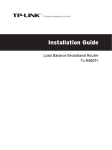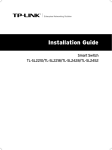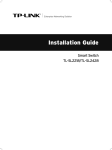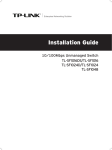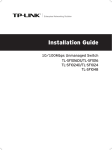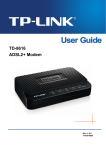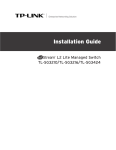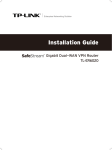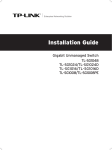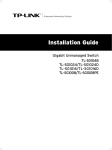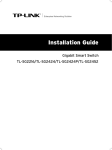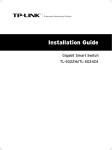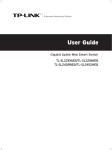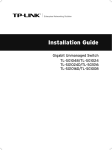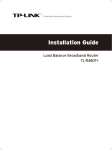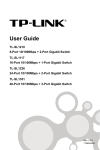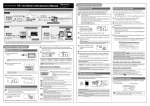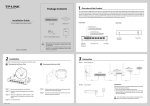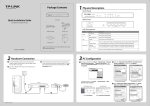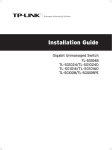Download TP-Link TL-SL1226 V3 Installation Guide
Transcript
Enterprise Networking Solution Installation Guide Gigabit Uplink Unmanaged Switch TL-SL1226/TL-SL1351 COPYRIGHT & TRADEMARKS Specifications are subject to change without notice. is a registered trademark of TP-LINK TECHNOLOGIES CO., LTD. Other brands and product names are trademarks of their respective holders. No part of the specifications may be reproduced in any form or by any means or used to make any derivative such as translation, transformation, or adaptation without permission from TP-LINK TECHNOLOGIES CO., LTD. Copyright © 2013 TP-LINK TECHNOLOGIES CO., LTD. All rights reserved. http://www.tp-link.com FCC STATEMENT This equipment has been tested and found to comply with the limits for a Class A digital device, pursuant to part 15 of the FCC Rules. These limits are designed to provide reasonable protection against harmful interference when the equipment is operated in a commercial environment. This equipment generates, uses, and can radiate radio frequency energy and, if not installed and used in accordance with the instruction manual, may cause harmful interference to radio communications. Operation of this equipment in a residential area is likely to cause harmful interference in which case the user will be required to correct the interference at his own expense. This device complies with part 15 of the FCC Rules. Operation is subject to the following two conditions: 111 This device may not cause harmful interference. 222 This device must accept any interference received, including interference that may cause undesired operation. Any changes or modifications not expressly approved by the party responsible for compliance could void the user’s authority to operate the equipment. CE Mark Warning This is a Class A product. In a domestic environment, this product may cause radio interference, in which case the user may be required to take adequate measures. I Copyright & Trademarks Related Document This Installation Guide is also available in PDF on our website. To obtain the latest documentation and prodcut information, please visit the official website: http://www.tp-link.com About this Installation Guide This Installation Guide describes the hardware characteristics, installation methods and the points that should be attended to during installation. This Installation Guide is structured as follows: Chapter 1 Introduction. This chapter describes the external components of the switch. Chapter 2 Installation. This chapter illustrates how to install the switch. Chapter 3 Lightning Protection. This chapter illustrates how to prevent lightning damage. Chapter 4 Connection. This chapter illustrates how to do the physical connection of the switch. Appendix A Hardware Specifications. Appendix B Technical Support. Audience This Installation Guide is for: Network Engineer Network Administrator Conventions Due to the similarity in structure of TL-SL1226/TL-SL1351 Gigabit Uplink Unmanaged Switch series, in this Installation Guide we take TL-SL1351 as an example to illustrate Chapter 2 Installation, Chapter 3 Lightning Protection and Chapter 4 Connection. This Guide uses the specific formats to highlight special messages. The following table lists the notice icons that are used throughout this guide. Remind to be careful. A caution indicates a potential which may result in device damage. Remind to take notice. The note contains the helpful information for a better use of the product. Related Document II Contents Chapter 1 Introduction ——————————— 01 1.1 Product Overview ...................................................................01 1.2 Features ......................................................................................01 1.3 Appearence ...............................................................................02 Chapter 2 Installation ———————————— 04 2.1 Package Contents ...................................................................04 2.2 Safety Precautions ..................................................................04 2.3 Installation Tools......................................................................06 2.4 Product Installation ................................................................07 Chapter 3 Lightning Protection ———————— 09 3.1 Cabling Reasonably................................................................09 3.2 Connect to Ground.................................................................11 3.3 Equipotential Bonding ..........................................................12 3.4 Use Lightning Arrester ..........................................................13 Chapter 4 Connection ——————————— 15 4.1 Ethernet Port ............................................................................15 4.2 SFP Port ......................................................................................15 4.3 Verify Installation ....................................................................15 4.4 Power On....................................................................................16 4.5 Initialization ..............................................................................16 Appendix A Hardware Specifications —————— 17 Appendix B Technical Support ————————— 18 III Contents Gigabit Uplink Unmanaged Switch CCCCCCCCCC Introduction 1111 Product Overview TL-SL1226/TL-SL1351 Gigabit Uplink Unmanaged Switch provides you with a highperformance, low-cost, easy-to-use, seamless and standard upgrade to boost your old network to 1000Mbps. Increase the speed of your network server and backbone connections, making Gigabit connection to a server or uplinking a network necessarily. The TP-LINK TL-SL1226/TL-SL1351 Gigabit Uplink Unmanaged Switch features a nonblocking switching architecture that forwards and filters packets at full wire-speed for maximum throughput. The switch supports MAC address auto-learning and auto-aging, IEEE802.3x flow control for Full Duplex mode and backpressure for Half Duplex mode. It is compatible with all 10Mbps, 100Mbps and 1000Mbps Ethernet devices because it is standard-based. The TL-SL1226/TL-SL1351 Gigabit Uplink Unmanaged Switch is plug-and-play and no configuration is required. Auto MDI/MDIX cable detection on all ports eliminates the need for crossover cable or Uplink port. Each port can be used as general ports or Uplink ports, and any port can be simply plugged into a server, a hub, a router or a switch, using the straight cable or crossover cable. Diagnostic LEDs which display link status and activity allow you to quickly detect and correct problems on the network. 1111 Features ¾¾ Complies with IEEE802.3, IEEE802.3u, IEEE802.3ab, IEEE802.3z (for TL-SL1351 only) standards ¾¾ 24/48 10/100Mbps Auto-Sense RJ45 ports supporting Auto-MDI/MDIX ¾¾ 2/2 10/100/1000Mbps Auto-Sense RJ45 ports supporting Auto-MDI/MDIX ¾¾ 1 SFP(Small Form Pluggable) module interface (For TL-SL1351 only) ¾¾ Supports Auto MDI / MDIX cable detection on all ports eliminate the need for crossover cable or Uplink port ¾¾ Non-blocking switching architecture that forwards and filters packets at full wire -speed for maximum throughput ¾¾ Supports MAC address auto-learning and auto-aging ¾¾ Supports IEEE802.3x flow control for full-duplex mode and backpressure for halfduplex transfer mode ¾¾ LED indicators for monitoring power, link, activity, speed ¾¾ Internal power supply Introduction 01 Gigabit Uplink Unmanaged Switch 1111 Appearence ■■ Front Panel The front panel of TL-SL1226 is shown as the following figure. LEDs 10/100Mbps RJ45 Port 10/100/1000Mbps RJ45 Port Figure 1-1 Front Panel of TL-SL1226 The front panel of TL-SL1351 is shown as the following figure. LEDs 10/100Mbps RJ45 Port 10/100/1000Mbps RJ45 Port SFP Port Figure 1-2 Front Panel of TL-SL1351 Port Feature Model 10/100Mbps RJ45 Port 10/100/1000Mbps RJ45 Port SFP Port TL-SL1226 24 2 - TL-SL1351 48 2 1 LEDs LED Power Link/Act 1000Mbps Status Indication On The switch is powered on Flashing Power supply is abnormal Off The switch is powered off or power supply is abnormal On A device is connected to the corresponding port, but no data is being transmitted or received Flashing Data is being transmitted or received Off No device is connected to the corresponding port On The corresponding port is running at 1000Mbps Flashing Data is being transmitted or received Off There is no device linked to the corresponding port or the port is running at 10Mbps or 100Mbps 10/100Mbps Port Designed to connect to the device with a bandwidth of 10Mbps or 100Mbps. 02 Introduction Gigabit Uplink Unmanaged Switch 10/100/1000Mbps Port Designed to connect to the device with a bandwidth of 10Mbps, 100Mbps or 1000Mbps. Each has a corresponding 1000Mbps LED. SFP Port (for TL-SL1351 Only) Designed to install the SFP module. TL-SL1351 features one individual SFP port. ■ Rear Panel The rear panel of TL-SL1226 is shown as the following figure. Figure 1-3 Rear Panel of TL-SL1226 The rear panel of TL-SL1351 is shown as the following figure. Figure 1-3 Rear Panel of TL-SL1351 Grounding Terminal The switch already comes with lightning protection mechanism. You can also ground the switch through the PE (Protecting Earth) cable of AC cord or with Ground Cable. For detailed information, please refer to Chapter 3 Lightning Protection. Power Socket Connect the female connector of the power cord here, and the male connector to the AC power outlet. Please make sure the voltage of the power supply meets the requirement of the input voltage (100-240V~ 50/60Hz). Caution: Please use the provided power cord. Introduction 03 Gigabit Uplink Unmanaged Switch Chapter 2 Installation 2.1 Package Contents Make sure that the package contains the following items. If any of the listed items is damaged or missing, please contact your distributor. One Switch One Power Cord This Installation Guide Two mounting brackets and the fittings 2.2 Safety Precautions To avoid any device damage and bodily injury caused by improper use, please observe the following rules. ■■ Safety Precautions ■■ Keep the power off during the installation. ■■ ■■ ■■ Installation Use only the power cord provided with the switch. Make sure that the supply voltage matches the specifications indicated on the rear panel of the switch. ■■ Ensure the vent hole is well ventilated and unblocked. ■■ Do not open or remove the cover of the switch. ■■ 04 Wear an ESD-preventive wrist strap, and make sure that the wrist strap has a good skin contact and is well grounded. Before cleaning the device, cut off the power supply. Do not clean it by the waterish cloth, and never use any other liquid cleaning method. Gigabit Uplink Unmanaged Switch ■■ Site Requirements To ensure normal operation and long service life of the device, please install it in an environment that meets the requirements described in the following subsection. Temperature/Humidity ȭ ȭ Please keep a proper temperature and humidity in the equipment room. Too high/low humidity may lead to bad insulation, electricity leakage, mechanical property changes and corrosions. Too high temperature may accelerate aging of the insulation materials and can thus significantly shorten the service life of the device. For normal temperature and humidity of the device, please check the following table. Environment Temperature Humidity Operating 0℃ ~ 40℃ 10% ~ 90%RH Non-condensing Storage -40℃ ~ 70℃ 5% ~ 90%RH Non-condensing Clearness The dust accumulated on the switch can be absorbed by static electricity and result in poor contact of metal contact points. Some measures have been taken for the device to prevent static electricity, but too strong static electricity can cause deadly damage to the electronic elements on the internal circuit board. To avoid the effect of static electricity on the operation of the switch, please attach much importance to the following items: ■■ Dust the device regularly, and keep the indoor air clean. ■■ Keep the device well grounded and ensure static electricity has been transferred. Electromagnetic Interference Electronic elements including capacitance and inductance on the device can be affected by external interferences, such as conducted emission by capacitance coupling, inductance coupling, and impedance coupling. To decrease the interferences, please make sure to take the following measures: ■■ ■■ ■■ Use the power supply that can effectively filter interference from the power grid. Keep the device far from high-frequency, strong-current devices, such as radio transmitting station. Use electromagnetic shielding when necessary. Installation 05 Gigabit Uplink Unmanaged Switch Lightening Protection Extremely high voltage currents can be produced instantly when lightning occurs and the air in the electric discharge path can be instantly heated up to 20,000℃. As this instant current is strong enough to damage electronic devices, more effective lightning protection measures should be taken. ■■ Ensure the rack and device are well earthed. ■■ Make sure the power socket has a good contact with the ground. ■■ Keep a reasonable cabling system and avoid induced lightning. ■■ Use the signal SPD (Surge Protective Device) when wiring outdoor. Note: For detailed lightning protection measures, please refer to Chapter 3 Lightning Protection. Installation Site S When installing the device on a rack or a flat workbench, please note the following items: ■■ ■■ ■■ The rack or workbench is flat and stable, and sturdy enough to support the weight of 5.5kg at least. The rack or workbench has a good ventilation system. The equipment room is well ventilated. The rack is well grounded. Keep the power socket less than 1.5 meters away from the device. 2.3 Installation Tools ■■ Phillips screwdriver ■■ ESD-preventive wrist wrap ■■ Cables Note: These tools are not provided with our product. If needed, please self purchase them. 06 Installation Gigabit Uplink Unmanaged Switch 2.4 Product Installation ■■ Desktop Installation To install the device on the desktop, please follow the steps: 111Set the device on a flat surface strong enough to support the entire weight of the device with all fittings. 222Remove the adhesive backing papers from the rubber feet. 333Turnover the device and attach the supplied rubber feet to the recessed areas on the bottom at each corner of the device. Feet Bottom of the Device Notch Figure 2-1 Desktop Installation ■■ Rack Installation To install the device in an EIA standard-sized, 19-inch rack, follow the instructions described below: 111Check the grounding and stability of the rack. 222Secure the supplied rack-mounting brackets to each side of the device with supplied screws, as illustrated in the following figure. Rack-mounting Bracket Screw Figure 2-2 Bracket Installation 333After the brackets are attached to the device, use suitable screws (not provided) to secure the brackets to the rack, as illustrated in the following figure. Installation 07 Gigabit Uplink Unmanaged Switch Rack Figure 2-3 Rack Installation Caution: Please set 5~10cm gaps around the device for air circulation. Please avoid any heavy thing placed on the device. Please mount devices in sequence from the bottom to top of the rack and ensure a certain clearance between devices for the purpose of heat dissipation. ■■ ■■ ■■ 08 Installation Gigabit Uplink Unmanaged Switch Chapter 3 Lightning Protection 3.1 Cabling Reasonably In the actual network environment, you may need cable outdoors and indoors, and the requirements for cabling outdoors and indoors are different. A reasonable cabling system can decrease the damage of induced lightning to devices. Note: It's not recommended using Ethernet cables outdoors. When cabling outdoors, please use a signal lightning arrester. ■■ Requirements for Cabling Outdoors ■■ Aerial cabling without safeguard is not allowed. ■■ ■■ ■■ ■■ It’s not allowed cabling down the building to connect network devices in different floors. Outdoor cables should be buried and paved to the indoor through basement. A piece of steel wire should be paved underground along the pipe and connected to the lightning protection terminal of the building for shielding. Before connecting the cable to the device, install a signal lightning arrester on the corresponding port. When an aerial cable is set up, the cable should be through a metal pipe (15m long at least) before coming into the building. The two ends of this metal pipe should be grounded. Before connecting the cable to the device, install a signal lightning arrester on the corresponding port. It’s not necessary to pave STP cables through pipes. The shielded layer of STP cable should be well grounded. Before connecting the cable to the device, install a signal lightning arrester on the corresponding port. Lightning Protection 09 Gigabit Uplink Unmanaged Switch ■■ Requirements for Cabling Indoors When cabling indoors, keep a certain distance away from the devices that may cause high-frequency interferences, such as down-conductor cable, powerline, power transformer and electromotor. ■■ ■■ The main cable should be paved in the metal raceway of the access shaft. When cabling, keep the loop area formed by the cable itself as small as possible. Requirements for the distance between Ethernet cable and other pipelines are shown in the table. Ethernet Cable Other Pipelines Min Parallel Net Length L (mm1 Min Parallel-overlapping Net Height H (mm1 Down-conductor 1000 300 PE 50 20 Service pipe 150 20 Compressed air pipe 150 20 Thermal pipe (not wrapped1 500 500 Thermal pipe (wrapped1 300 300 Gas pipe 300 20 The two diagrams below demonstrate parallel net length and parallel-overlapping net height. Note: The above minimum net length/height is required when metal raceway is not used. If any requirements cannot be met, you can add a steel tube or metal raceway for shielding. ■■ 10 Requirements for the distance between Ethernet cable and high-power electric devices are in following tables. Min Parallel Length (mm1 Cable Pave Way Parallel cabling 130 <2kVA powerline One is in the grounded metal raceway or metal pipe 70 The both are in the grounded metal raceway or metal pipe 10 2~5kVA powerline Parallel cabling 300 One is in the grounded metal raceway or metal pipe 150 The both are in the grounded metal raceway or metal pipe 80 >5kVA powerline Parallel cabling 600 One is in the grounded metal raceway or metal pipe 300 The both are in the grounded metal raceway or metal pipe 150 Lightning Protection Gigabit Uplink Unmanaged Switch Device Min Distance (m1 Switch case 1.00 Transformer room 2.00 Elevator tower 2.00 Air-conditioner room 2.00 3.2 Connect to Ground Connecting the device to ground is to quickly release the lightning over-voltage and over-current of the device, which is also a necessary measure to protect the body from electric shock. In different environments, the device may be grounded differently. The following will instruct you to connect the device to the ground in two ways, connecting to the grounding bar or connecting to the ground via the power cord. Please connect the device to ground in the optimum way according to your specific operation environment. ■■ Connecting to the Grounding Bar If the device is installed in the Equipment Room, where a grounding bar is available, you are recommended to connect the device to the grounding bar as shown in the following figure. Switch (Rear Panel) Grounding Terminal Ground Cable Grounding Bar Figure 3-1 Connecting to the Grounding Bar Note: The grounding bar and the ground cable are not provided with our product. If needed, please self purchase them. Lightning Protection 11 Gigabit Uplink Unmanaged Switch ■■ Connecting to the Ground via the Power Supply If the device is installed in the normal environment, the device can be grounded via the PE (Protecting Earth) cable of the AC power supply as shown in the following figure. Figure 3-2 Connecting to the Ground Note: The figure is to illustrate the application and principle. The power plug you get from the package and the socket in your situation will comply with the regulation in your country, so they may differ from the figure above. If you intend to connect the device to the ground via the PE (Protecting Earth) cable of AC power cord, please make sure the PE (Protecting Earth) cable in the electrical outlet is well grounded in advance. ■■ ■■ 3.3 Equipotential Bonding Equipotential Bonding is the practice of intentionally electrically connecting all earthed systems to the same grounding grid or connecting the grounding grids of all the earthed systems together through the ground or overground metal so as to create an earthed equipotential zone. When lightning occurs, the high voltage produced by lightning current in all systems will meanwhile exist in their ground cables, and thus all ground cables have the same electrical potential and basically eliminate the electric strikes between the systems. The figure below illustrates how to practice equipotential bonding in a network. 12 Lightning Protection Gigabit Uplink Unmanaged Switch Grounding Terminal Equipotential Bonding Cable Ground Cable Grounding Bar Figure 3-3 Equipotential Bonding When equipotential bonding, please note that the cable should be copper wrapped 2 Kelly with its area being 6mm at least. The shorter cable the better, and use a grounding bar to establish an equipotential bonding point. Note: The equipotential bonding cable is not provided with our product. If needed, please self purchase it. 3.4 Use Lightning Arrester Power lightning arrester and signal lightning arrester are used for lighting protection. Power lightning arrester is used for limiting the voltage surge due to a lightning. If an outdoor AC power cord should be directly connected to the device, please use a power lightning arrester. Note: Power lightning arrester is not provided with our product. If needed, please self purchase it. Lightning Protection 13 Gigabit Uplink Unmanaged Switch Signal lightning arrester is used to protect RJ45 ports of the device from lightning. When cabling outdoors, please install a signal lightning arrester before connecting the cable to the device. When purchasing or using a signal lightning arrester, please observe the following rules: ■■ ■■ The port rate of the signal lightning arrester should match the rate of the desired port on the device. If it is not matched, this signal lighting arrester will not work. Purchase a standard lightning arrester. Install signal lightning arrester near the protected device and connect it to the ground via a shorter ground cable. Grounding Terminal Equipotential Bonding Cable Signal Lightning Arrester Device Ethernet Cable Figure 3-4 Equipotential Bonding Note: Signal lightning arrester is not provided with our product. If needed, please self purchase it. 14 Lightning Protection Gigabit Uplink Unmanaged Switch Chapter 4Connection 4.1 Ethernet Port Please connect the Ethernet ports of the switch to the networkdevices by RJ45 cable as the following figure shown. RJ45 Port RJ45 Cable Figure 4-1 Connecting the RJ45 Port 4.2 SFP Port Connect the SFP port to a SFP module. The switch could identify and configure the SFP module automatically (for TL-SL1351 only). SFP Port SFP Module Figure 4-2 Inserting the SFP Module 4.3 Verify Installation After completing the installation, please verify the following items: ■■ There are 5~10cm of clearance around the sides of the device for ventilation and the air flow is adequate. ■■ The voltage of the power supply meets the requirement of the input voltage of the device. ■■ The power socket, device and rack are well grounded. ■■ The device is correctly connected to other network device. Connection 15 Gigabit Uplink Unmanaged Switch 4.4 Power On Plug in the female connector of the provided power cord into the power socket of the device, and the male connector into a power outlet as the following figure shown. Figure 4-3 Connecting to Power Supply Note: The figure is to illustrate the application and principle. The power plug you get from the package and the socket in your situation will comply with the regulation in your country, so they may differ from the figure above. 4.5 Initialization After the device is powered on, it begins the Power-On Self-Test. A series of tests run automatically to ensure the device functions properly. During this time, its LED indicators will respond as follows: ■■ ■■ 16 Connection For TL-SL1226, the Power LED indicator will light up first and remain ON. After about three seconds, all port LED indicators will light up for three seconds and then go off. This process indicates that the device is successfully initialized. For TL-SL1351, the Power LED indicator will light up first and remain ON. Other LED indicators will light up for one second and then go off. This process indicates that the device is successfully initialized. Gigabit Uplink Unmanaged Switch Appendix A Hardware Specifications Item Content IEEE802.3 10Base-T IEEE802.3u 100Base-TX Standards IEEE802.3ab 1000Base-T IEEE802.3z 1000Base-X (for TL-SL1351 only1 ANSI/IEEE Std 802.3 Nway IEEE802.3x 10Base-T: UTP/STP of Cat. 3 or above(maximum 100m1 Transmission Medium 100Base-TX: UTP/STP of Cat. 5 or above(maximum 100m1 1000Base-TX: UTP/STP of Cat. 5 or above(maximum 100m1 Safety & Emissions FCC, CE Transfer Method Store-and-Forward MAC Address Learning Automatically learning, automatically aging 10Base-T: 14880pps/Port Frame Forward Rate 100Base-TX: 148810pps/Port 1000Base-T: 1488095pps/Port 1000Base-X: 1488095pps/Port (for TL-SL1351 only1 LEDs Power, Link/Act, 1000Mbps Operating Temperature 0℃~40℃ Storage Temperature -40℃~70℃ Operating Humidity 10%~90%RH Non-condensing Storage Humidity 5%~90%RH Non-condensing Hardware Specifications 17 Gigabit Uplink Unmanaged Switch Appendix B Technical Support ■■ For more troubleshooting help, go to: http://www.tp-link.com/en/support/faq ■■ To download the latest Firmware, Driver, Utility and User Guide, go to: http://www.tp-link.com/en/support/download ■■ 18 For all other technical support, please contact us by using the following details: Global Tel: +86 755 2650 4400 Fee: Depending on rate of different carriers, IDD. E-mail: [email protected] Service time: 24hrs, 7 days a week Singapore Tel: +65 6284 0493 Fee: Depending on rate of different carriers. E-mail: [email protected] Service time: 24hrs, 7 days a week UK Tel: +44 (01 845 147 0017 Fee: Landline: 1p-10.5p/min, depending on the time of day. Mobile: 15p-40p/min, depending on your mobile network. E-mail: [email protected] Service time: 24hrs, 7 days a week USA/Canada Toll Free: +1 866 225 8139 E-mail: [email protected](USA1 [email protected](Canada1 Service time: 24hrs, 7 days a week Turkey Tel: 0850 7244 488 (Turkish Service1 Fee: Depending on rate of different carriers. E-mail: [email protected] Service time: 09:00 to 21:00, 7 days a week Italy Tel: +39 023 051 9020 Fee: Depending on rate of different carriers. E-mail: [email protected] Service time: Monday to Friday, 09:00 to 13:00; 14:00 to 18:00 Ukraine Tel: 0800 505 508 Fee: Free for Landline; Mobile: Depending on rate of different carriers E-mail: [email protected] Service time: Monday to Friday, 10:00 to 22:00 Malaysia Toll Free: 1300 88 875 465 Email: [email protected] Service time: 24hrs, 7 days a week Brazil Toll Free: 0800 608 9799 (Portuguese Service1 E-mail: [email protected] Service time: Monday to Friday, 09:00 to 20:00; Saturday, 09:00 to 15:00 Poland Tel: +48 (01 801 080 618 +48 223 606 363 (if calls from mobile phone1 Fee: Depending on rate of different carriers. E-mail: [email protected] Service time: Monday to Friday, 09:00 to 17:00. GMT+1 or GMT+2 (DST1 Technical Support Gigabit Uplink Unmanaged Switch Indonesia Tel: (+621 021 6386 1936 Fee: Depending on rate of different carriers. E-mail: [email protected] Service time: Sunday to Friday, 09:00 to 12:00, 13:00 to 18:00 *Except public holidays France Tel: 0820 800 860 (French service1 Fee: 0.118 EUR/min from France Email: [email protected] Service time: Monday to Friday, 09:00 to 18:00 *Except French Bank holidays Australia/New Zealand Tel: NZ 0800 87 5465 (Toll Free1 AU 1300 87 5465 (Depending on 1300 policy.1 E-mail: [email protected] (Australia1 [email protected] (New Zealand1 Service time: 24hrs, 7 days a week Switzerland Tel: +41 (01 848 800 998 (German Service1 Fee: 4-8 Rp/min, depending on rate of different time. E-mail: [email protected] Service time: Monday to Friday, 09:00 to 12:30 and 13:30 to 18:00. GMT+1 or GMT+2 (DST1 Germany/Austria Tel: +49 1805 875 465 (German Service1 +49 1805 TPLINK +43 820 820 360 Fee: Landline from Germany: 0.14EUR/min. Landline from Austria: 0.20EUR/min. E-mail: [email protected] Service time: Monday to Friday, 09:00 to 12:30 and 13:30 to 18:00. GMT+1 or GMT+2 (DST in Germany1 *Except bank holidays in Hesse Russian Federation Tel: 8 (4991 754 5560 (Moscow NO.1 8 (8001 250 5560 (Toll-free within RF1 E-mail: [email protected] Service time: From 09:00 to 21:00 (Moscow time1 *Except weekends and holidays in RF Technical Support 19 Website: http://www.tp-link.com E-mail: [email protected] 7106504529 Rev4.0.0
























